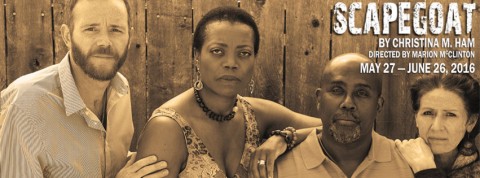After Elaine: History and present converse in Christina Ham's SCAPEGOAT
It is impossible to walk away from a Christina Ham play without feeling more informed about relevant social topics or little-known histories. She has this incredible ability to educate the audience in a dramatic and entertaining way that sticks with you and pushes for further conversation. This is certainly true for Ham’s Scapegoat, a two-part play exploring how racial issues of the past can still haunt us today. The play revolves around Elaine, Arkansas, a city known to few, with a history seldom discussed. In 1919, this city was the home of one of the largest race riots in American history, called the Elaine Massacre.
“I had stumbled across Ida B. Wells’ account of the Elaine Race Riots, and I had no idea what they were,” says Ham. “As I started reading about them, I had no idea that it was one of the worst race riots in U.S. history.”
Scapegoat was first developed at the Playwrights’ Center during Ham’s year as a McKnight Fellow in Playwriting, and later during 2013 PlayLabs when she was a Core Writer. Ham is a notoriously aggressive rewriter, and each draft of the play has been quite different.
The play started as a one-act following the events leading to the Elaine Massacre. One of the lead characters was a sin eater (someone who absorbs a deceased person’s sins through ritual eating) before Ham decided to go in a new direction. During her McKnight workshop, she was playing with different ways to structure the play, which led to dividing the story into two different parts. Part One focuses on Elaine, Arkansas in 1919 while Part Two is present day Elaine. Along with the shift in time, there is a drastic shift in tone. Part One has a dark and dramatic tone while Part Two is much lighter and will give the audience plenty of laughs.
“I was cracking myself up coming to the Center because I was like, ‘Oh I know how I’m gonna mess with them now.’” Describing the actors’ reaction to Part Two, Ham says, “They never thought in a million years that was the direction that the play was headed.”
Ham continued to develop her script during PlayLabs. “The PlayLabs workshop was instrumental in getting the play ready for production,” she says. “The workshop provided time and a safe place to make choices that did or did not work.” She left PlayLabs with a better understanding of the theme of the play and what it means to her. “We are indebted to the legacy of what happened to these people. How do we do things differently so that their lost lives will not be in vain?”
Three years later, Pillsbury House Theatre is giving Scapegoat its premiere performance on May 27. Though Scapegoat was not developed as a partnership project, the Playwrights’ Center and Pillsbury House have a long relationship, having collaborated to develop plays such as Tracey Scott Wilson’s Buzzer.
During Scapegoat’s run at Pillsbury House, those who have attended readings of previous drafts will notice changes to the storytelling, but will be excited to see that the same cast of actors will be telling that story. “These actors have lived in the characters’ skins for a long time, and they are able to go deeper into their characters,” says Ham.
Scapegoat runs through June 26 at Pillsbury House Theatre.


 Facebook
Facebook Twitter
Twitter